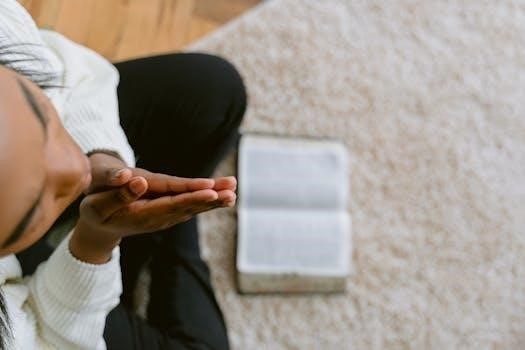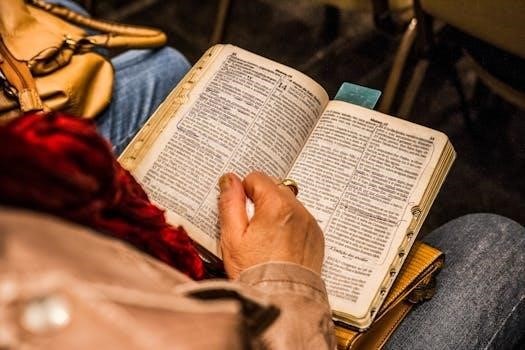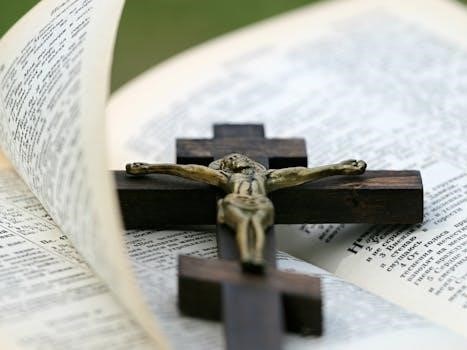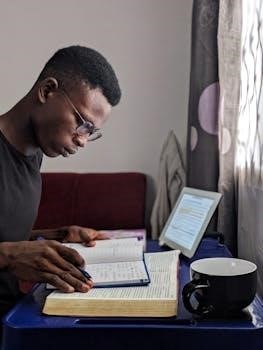Freemason Bible PDF⁚ Exploring its Significance and Context
The Freemason Bible, often sought in PDF format, represents the Volume of Sacred Law (VSL), a central element in Masonic lodges․ While often a Bible, the VSL can vary, encompassing other sacred texts like the Quran, Tanakh, or Vedas, depending on the members’ beliefs․ This emphasizes Freemasonry’s inclusiveness․
Freemasonry, a worldwide fraternal organization, employs a rich tapestry of symbols and texts to impart its teachings․ Its roots, though debated, are often traced back to ancient mysteries and the traditions of operative stonemasons․ The organization emphasizes moral development, using allegorical stories and rituals to guide members towards self-improvement․ Central to Freemasonry is the concept of the Volume of Sacred Law (VSL), which serves as a focal point during lodge meetings․ This book, often a Bible in Anglo-American lodges, is not meant to be a religious text but rather a symbol of divine guidance and moral law․ The selection of the VSL acknowledges that people from diverse backgrounds can unite under principles of virtue․ Beyond the VSL, Masonic texts include ritual books, lectures, and historical documents that explain its philosophy, history, and practices․ These resources provide context for the rituals and symbols, helping members understand the underlying principles of the fraternity․ Freemasonry does not impose a specific religion, but it encourages members to explore their own spiritual beliefs while adhering to a common framework of moral values․ The texts, therefore, are tools for this personal exploration․
The Volume of Sacred Law (VSL) in Freemasonry

The Volume of Sacred Law (VSL) is a fundamental element within Freemasonry, representing the spiritual and moral foundation upon which the organization’s principles are built․ It’s not a specific book, but rather a term referring to any text that a member considers sacred and that is used in the lodge during meetings․ This reflects Freemasonry’s inclusive nature, allowing members from different religious and philosophical backgrounds to participate without compromising their beliefs․ In Anglo-American Freemasonry, the Bible often serves as the VSL, but other texts like the Quran, Tanakh, Vedas, or even a blank book symbolizing all faiths, are used in lodges with diverse memberships․ The VSL is always open during meetings, signifying that the members are working under the moral law․ It’s not meant to be interpreted as a literal guide for Masonic teachings but rather as a symbol of the higher power and the moral principles that guide Freemasonry․ The VSL, therefore, serves as a reminder of the importance of ethical conduct and the search for truth․ The selection of the VSL is left to the discretion of the lodge, ensuring that it resonates with the beliefs of its members and is used not as a dogma, but as a symbolic representation of the individual’s faith․
The Bible as a VSL in Anglo-American Freemasonry
In Anglo-American Freemasonry, the Bible holds a prominent position as the Volume of Sacred Law (VSL)․ Its use isn’t necessarily about enforcing a specific religious doctrine, but rather as a symbol of moral law and divine guidance․ The Bible, in this context, serves as a representation of the principles of righteousness, truth, and justice that Freemasonry aims to instill in its members․ It’s open during meetings as a reminder of the moral code to which Freemasons are supposed to adhere․ The selection of the Bible as the VSL is largely due to the historical and cultural context of Anglo-American Freemasonry, which has deep roots in Western traditions․ However, it’s crucial to note that Freemasonry is not a religion and doesn’t require members to be Christian․ The Bible’s role is more symbolic than literal, offering a familiar and respected text for members to reflect upon․ Its narratives, parables, and teachings are used as allegories for moral and ethical lessons, focusing on concepts like brotherly love, relief, and truth․ The specific passages used in Masonic rituals are often chosen for their relevance to these principles, rather than their religious significance․ It serves as a cornerstone of the lodge, a guiding principle in their pursuit of self-improvement․
Alternative Sacred Texts Used in Masonic Lodges
While the Bible is common, particularly in Anglo-American Freemasonry, alternative sacred texts are utilized in lodges to accommodate the diverse religious backgrounds of its members․ The Volume of Sacred Law (VSL) is not limited to the Bible; it can be any book deemed sacred by the individual members․ This inclusivity is a core tenet of Freemasonry, recognizing the value of different faiths․ Lodges may use the Quran, the Tanakh, the Vedas, or other texts that represent the beliefs of their members․ This flexibility ensures that all members, regardless of their religious affiliation, can find a meaningful connection to the VSL․ The selection of an alternative sacred text often depends on the demographics of the lodge and the preferences of its members․ The presence of diverse religious texts signifies that Freemasonry is not tied to a single faith․ It emphasizes the importance of universal moral principles shared across different religions․ The VSL is open on the altar during meetings, serving as a constant reminder of the moral and ethical standards that Freemasons strive to uphold․ This reflects the broader Masonic philosophy of embracing different paths toward self-improvement and spiritual growth․ Each text is respected and regarded as a source of wisdom, regardless of its origin․

The Role of the Book of Law in Freemasonry
The Book of Law, often synonymous with the Volume of Sacred Law (VSL), plays a crucial role in Freemasonry․ It serves as a guiding principle, a moral compass for the members, and a symbol of the higher power they acknowledge․ It is not necessarily a specific religious text, but a representation of the moral laws that underpin Masonic teachings․ The Book of Law is displayed open on the altar during lodge meetings, symbolizing the importance of these principles in the work of Freemasonry․ It serves as a focal point for contemplation and reflection on the ethical and spiritual aspects of life․ The Book of Law is also a reminder that Freemasonry is not a substitute for religion, but a complementary system designed to make good men better․ Some Masonic interpretations view the Book of Law as an amalgamation of all sacred texts, encompassing the wisdom and teachings of various faiths; Other interpretations see it as a blank book, symbolizing the potential for all faiths and spiritual beliefs to be recognized․ Regardless of the specific text or interpretation, the Book of Law acts as a constant reminder of the values of morality, integrity, and service that are central to Masonic philosophy․
Masonic Rituals and the Use of Sacred Texts
Masonic rituals prominently feature the use of sacred texts, underscoring their significance in the fraternity’s practices․ The chosen text, often a Bible in Anglo-American lodges, is not merely a prop; it is an integral element of the ceremonies, serving as a foundation for the moral lessons being imparted․ During initiations and other degrees, passages from the sacred text are often read aloud, reinforcing the values of truth, justice, and brotherly love that are central to Freemasonry․ These readings are not simply recitations but are meant to inspire contemplation and encourage the candidate to align their life with these principles․ The sacred text is also physically present on the altar, a symbolic representation of the divine presence within the lodge․ It serves as a constant reminder of the moral and ethical obligations that each Mason undertakes․ The specific passages used are often related to the themes of the degree being conferred, adding depth and meaning to the ritual․ The manner in which the sacred text is handled and presented reflects the respect and reverence it commands within Masonic tradition․
Masonic Lectures and their Connection to Texts
Masonic lectures play a crucial role in educating members about the symbolism, philosophy, and moral teachings of the craft, and these lectures are deeply intertwined with the sacred texts used within the lodge․ These oral presentations, often delivered during initiations and degree ceremonies, provide context and explanation for the rituals and symbols encountered․ Masonic lectures frequently draw upon the narratives and moral lessons found within the Volume of Sacred Law (VSL), which, in many cases, is the Bible․ The passages and stories from the VSL are not simply read but are interpreted and applied to the Masonic context, revealing deeper layers of meaning․ These lectures provide the background material necessary for initiates to understand the duties and responsibilities associated with each degree․ They also connect the historical and allegorical aspects of Freemasonry with the timeless principles found in the sacred texts․ These lectures are not meant to be a literal interpretation of the texts, but rather a framework for moral and spiritual development․ By connecting the lessons of the sacred texts to Masonic principles, the lectures help to create a cohesive and meaningful experience for the members․
Duncan’s Ritual⁚ A Look at Masonic Initiation

Duncan’s Ritual, a 19th-century publication, provides a detailed look at Masonic initiation ceremonies, offering insights into the procedures, grips, passwords, and regalia used within the craft․ While not an official Masonic text, it has become a well-known reference for those interested in the practical aspects of Freemasonry․ Duncan’s work describes the steps involved in each degree, from the Entered Apprentice to the Master Mason, outlining the symbolic actions and oaths taken by candidates․ It offers a glimpse into the structured nature of Masonic ritual and the sequential progression of knowledge and understanding that is central to the fraternity․ Though it presents details of the rituals, it is important to note that it should not be taken as an authoritative guide to modern Masonic practice, as variations exist across jurisdictions and time․ Duncan’s Ritual gives the uninitiated a sense of the ceremonies that link the candidate to the ancient mysteries and the foundational principles of Freemasonry․ It emphasizes the solemnity and seriousness with which Masonic initiations are conducted, revealing a pathway of self-discovery and personal growth․
Freemasonry and its Historical Roots
Exploring Freemasonry’s historical roots reveals a complex tapestry woven from various influences and traditions․ The origins of the fraternity are not definitively established, leading to various theories and interpretations․ Some trace its lineage back to the operative stonemasons of the Middle Ages, whose guilds possessed secret knowledge and practices․ Others point to the ancient mysteries and their symbolic systems as a source of Masonic ideas․ The biblical narrative of the construction of King Solomon’s Temple has also been incorporated into Masonic lore, providing a mythical foundation․ The dispersion of mankind after the Tower of Babel, with its confusion of tongues, also features in Masonic history, emphasizing the quest for universal understanding․ The Rosicrucians, with their alchemical and esoteric pursuits, are also sometimes connected to the development of Freemasonry․ The institution’s spread alongside the British Empire further shaped its global presence․ Ultimately, Freemasonry’s history reflects a blend of practical craft, symbolic tradition, and philosophical inquiry․
The Connection to Ancient Mysteries and Symbols
The connection between Freemasonry and ancient mysteries is evident in the symbolic language and rituals employed within the fraternity․ These ancient systems often used allegories and initiatory rites to convey profound spiritual and philosophical truths․ Freemasonry draws heavily from these traditions, incorporating symbols that represent the cosmos, the human condition, and the path towards enlightenment․ The vault symbolism of Enoch, for example, embodies the nine spheres of ancient Mysteries and the nine sacred strata of the earth, through which the initiate journeys․ The concept of the ‘Lost Word,’ central to Masonic teachings, reflects the quest for hidden wisdom․ The use of gematria, a numerological technique used in esoteric writings, further links Freemasonry to these mystical practices․ The All-Seeing Eye, a prominent Masonic symbol, is a potent example of the influence of ancient ideas․ These symbols serve as keys to unlocking deeper understanding and are central to the Masonic experience․
The Influence of Kabbalah on Masonic Texts
The influence of Kabbalah on Masonic texts is a subject of significant discussion among scholars and researchers․ Kabbalah, a mystical tradition within Judaism, offers a complex system of symbols, numerology, and esoteric interpretations of scripture․ Some Masonic texts and rituals exhibit striking parallels with Kabbalistic concepts and imagery․ The emphasis on hidden meanings, the use of symbolic language, and the exploration of spiritual truths are themes shared by both traditions․ Certain Masonic lectures and writings seem to acknowledge the influence of Kabbalah, identifying Masons as followers of Noah, a figure with significance in Kabbalistic thought․ Some scholars even suggest that the concept of the ‘Lost Word’ in Freemasonry could be linked to Kabbalistic notions of divine revelation and hidden knowledge․ While not all Masonic bodies explicitly endorse Kabbalah, its presence in certain aspects of Masonic philosophy and symbolism is undeniable, adding a layer of depth and complexity to the interpretation of Masonic texts․

Misconceptions About Freemasonry and Religion
Misconceptions about Freemasonry and its relationship with religion are widespread․ One common misunderstanding is the notion that Freemasonry is a religion itself․ This is incorrect; Freemasonry is a fraternal organization that uses moral teachings and symbolism to promote self-improvement․ While it incorporates elements of faith and spirituality, it does not impose a specific religious doctrine․ Another misconception is that Freemasonry is anti-religious․ This is also untrue․ Freemasonry requires its members to believe in a Supreme Being, but does not dictate which religion that belief should belong to․ The presence of a Volume of Sacred Law (VSL), often a Bible, in lodges can lead to the perception that Freemasonry is Christian-centric, when in reality, the VSL can be any text that holds sacred significance for the members․ Freemasonry’s focus is on ethical principles and personal development, not the promotion of a specific faith․ The organization aims to make good men better, regardless of their religious affiliation, or lack thereof, highlighting its commitment to inclusivity and tolerance․
Where to Find Information on Freemasonry and its Texts
Finding reliable information on Freemasonry and its texts, including the Freemason Bible PDF, requires navigating a landscape filled with both accurate resources and misinformation․ Reputable sources include official Grand Lodge websites, which often provide insights into their jurisdictions’ practices and beliefs, including discussions on the Volume of Sacred Law (VSL)․ Academic books and journals dedicated to the study of fraternal societies can offer scholarly perspectives on Masonic history, philosophy, and symbolism․ Websites like “Sacred Texts” provide access to various historical and religious texts, which can be helpful in understanding the context of Masonic symbolism and the use of sacred texts․ Additionally, books like “Freemasons for Dummies” can serve as introductory guides for those new to the subject․ Be cautious of sources that promote conspiracy theories or that lack credible citations, as they often misrepresent Masonic teachings and practices․ Seeking out balanced viewpoints from multiple sources is essential for developing a clear and informed understanding of Freemasonry and its complex relationship with sacred texts․